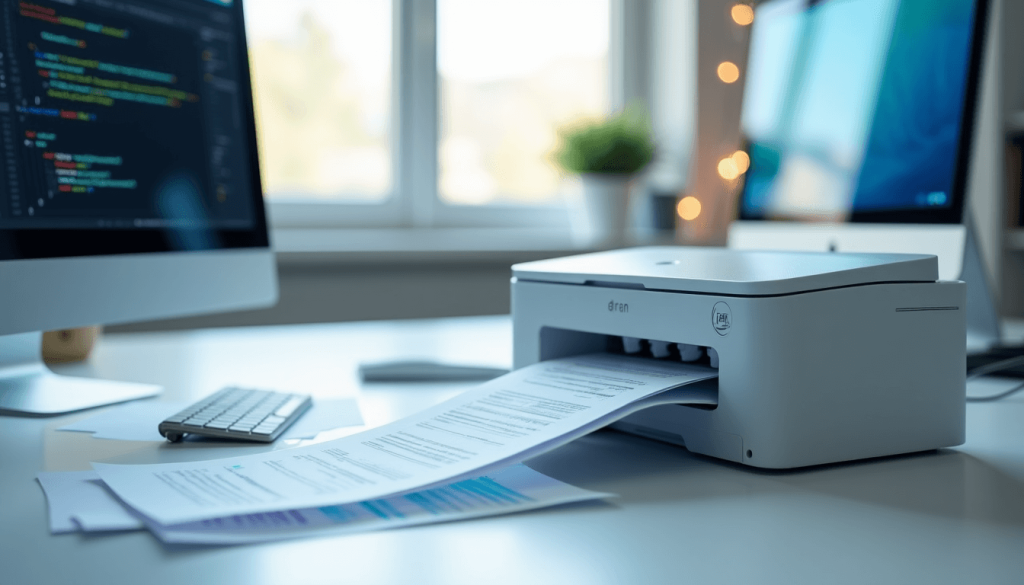PrintDocument C#: A step-by-step guide with examples

PrintDocument C# is a built-in class that makes it easy to send documents to a printer from your C# applications. Whether you’re printing text, images, or custom layouts, it gives you full control over the printing process.
Document printing remains a significant requirement for developers building business applications or document management systems.
C#’s PrintDocument provides a reliable solution that handles document printing tasks effectively—from simple text output to complex PDF processing.
Many developers struggle with printing implementation. The PrintDocument class in C# makes this process easier by offering a complete set of tools and methods to manage printing.
Your applications can control everything from simple page settings to advanced PDF printing capabilities. This makes PrintDocument a vital component when you need document output functionality.
This piece will help you become skilled at using PrintDocument in C#. The content covers fundamental concepts, shows how to implement simple printing functions, and explores advanced PDF printing techniques.
You’ll also find solutions to common printing challenges. After completing this tutorial, you can implement quick and reliable printing functionality in your C# applications.
TLDR: Learn how to implement document printing in C# applications using
PrintDocument, covering simple setup, PDF handling, and troubleshooting techniques.
Understanding PrintDocument class fundamentals
The PrintDocument class forms the backbone of C#’s printing architecture. It provides a framework to implement document printing without dealing with device-specific details. You need to understand how it works to build reliable printing solutions in your .NET applications.
PrintDocument in C# makes shared printing possible through an event-driven architecture. You can set up print jobs with simple properties and customize output by responding to printing events.
Core components and architecture of PrintDocument
PrintDocument‘s design follows an event-driven architecture that manages the rendering and printing process. The class creates print jobs, talks to printers, and coordinates rendering. It connects your application’s visual content to the physical printer and handles all the complex printer operations.
A Graphics object helps render content during printing. The class works with PrinterSettings and PageSettings to manage your printing configuration details.
Key properties for print configuration
PrintDocument comes with properties that let you control the printing process:
DocumentName: Sets the print job name in the printer queuePrinterSettings: Picks the printer, print quality, and paper optionsDefaultPageSettings: Sets page orientation, margins, and color optionsPrintController: Decides how to send the document to the printer
These properties give you detailed control over document processing before printing starts.
Essential events in the printing process
The printing workflow runs through these important events:
BeginPrint: Starts before printing and helps with setupQueryPageSettings: Runs before each page to let you adjust settingsPrintPage: The main event where content gets drawn on the pageEndPrint: Runs after printing to clean up resources
You must handle the PrintPage event. The other events are optional based on what you need.
PrintDocument vs third-party libraries
PrintDocument offers good native features for simple and medium printing tasks. Libraries like GdPicture.NET are great when you need more advanced features, especially with complex documents like PDFs.
🛠️ Installing GdPicture.NET SDK
To use the GdPicture.NET SDK in your C# application, follow these steps:
- Download the latest version from the official GdPicture.NET website.
- Run the installer and install it in a directory like
C:\GdPicture.NET\. - In your Visual Studio project:
- Add references to the GdPicture DLLs manually (from the installation folder),
OR - For .NET 6.0+ projects, open Project > Manage NuGet Packages, search for
GdPicture.API, and install the package.
- Add references to the GdPicture DLLs manually (from the installation folder),
- To activate GdPicture at runtime, use the
LicenseManagerclass:
using GdPicture14;
// Use a license key if you have one. Otherwise, leave it empty for trial mode.
LicenseManager licenseManager = new LicenseManager();
licenseManager.RegisterKEY("");
✅ Leaving the key empty ("") enables trial mode if a trial has already been activated through the GUI.
PrintDocument shines with its simplicity and .NET integration. GdPicture adds specialized PDF printing features like silent printing, printer selection, header/footer rendering, and quality control.
Implementing basic printing functionality
You now understand the fundamentals, so let’s add simple printing features to your C# applications. The practical implementation needs proper setup, event handling, and configuration management.
C# printing implementation requires a
PrintDocumentobject initialization,PrintPageevent handling, print settings configuration, and print operation execution with proper resource management.
Setting up your first PrintDocument implementation
using System.Drawing.Printing;
// Create a new PrintDocument instance
PrintDocument printDoc = new PrintDocument();
printDoc.DocumentName = "My First Document";
// Set up event handlers
printDoc.PrintPage += PrintDoc_PrintPage;
// Start printing
printDoc.Print();
Handling the PrintPage event
private void PrintDoc_PrintPage(object sender, PrintPageEventArgs e)
{
Graphics graphics = e.Graphics;
graphics.DrawString("Hello, Printing World!", new Font("Arial", 12),
Brushes.Black, new PointF(100, 100));
e.HasMorePages = false;
}
For multi-page documents, you’d typically track current pages and loop like this:
int currentPage = 0;
List<string> pages = GetDocumentPages(); // Assume this returns a list of strings to print
void PrintDoc_PrintPage(object sender, PrintPageEventArgs e)
{
e.Graphics.DrawString(pages[currentPage], new Font("Arial", 12), Brushes.Black, new PointF(50, 50));
currentPage++;
e.HasMorePages = currentPage < pages.Count;
}
Managing print settings and priorities
printDoc.PrinterSettings.PrinterName = "Microsoft Print to PDF";
printDoc.DefaultPageSettings.Landscape = true;
printDoc.DefaultPageSettings.Margins = new Margins(50, 50, 50, 50);
Use a print dialog to allow user configuration:
PrintDialog printDialog = new PrintDialog();
printDialog.Document = printDoc;
if (printDialog.ShowDialog() == DialogResult.OK)
{
printDoc.Print();
}
Creating a simple document printer
try
{
using (PrintDocument printDoc = new PrintDocument())
{
printDoc.DocumentName = "Simple Document";
printDoc.PrintPage += PrintDoc_PrintPage;
PrintDialog dialog = new PrintDialog { Document = printDoc };
if (dialog.ShowDialog() == DialogResult.OK)
{
printDoc.Print();
}
}
}
catch (Exception ex)
{
MessageBox.Show("Printing failed: " + ex.Message);
}
Advanced PrintDocument C# techniques for PDF documents
PDF document printing comes with unique challenges. PrintDocument alone can’t render PDF content — you’ll need third-party libraries like GdPicture.NET for best results.
Professional PDF printing in C# needs specialized rendering techniques, multi-page handling, header/footer integration, and quality optimization.
✅ Reminder: Add this namespace at the top of any GdPicture example:
using GdPicture14;
Rendering PDF content with PrintDocument
Instead of writing your own PDF renderer, GdPicture.NET handles everything:
using GdPicturePDF gdpicturePDF = new GdPicturePDF();
gdpicturePDF.LoadFromFile(@"C:\temp\source.pdf");
gdpicturePDF.Print();
gdpicturePDF.CloseDocument();
This skips PrintDocument entirely and handles rendering, layout, and optimization internally.
Multi-page PDF printing implementation
GdPicture handles pagination automatically:
IntPtr WINDOW_HANDLE = IntPtr.Zero;
gdpicturePDF.PrintShowPrinterSettingsDialog(WINDOW_HANDLE);
gdpicturePDF.PrintSetActivePrinter("printer1");
gdpicturePDF.Print();
If using PrintDocument manually, you’d need to loop and track pages as shown earlier.Adding headers and footers to PDF printouts
With PrintDocument, you can draw headers/footers in PrintPage:
e.Graphics.DrawString("Header", headerFont, Brushes.Gray, 100, 20);
e.Graphics.DrawString("Page 1", footerFont, Brushes.Gray, 100, e.MarginBounds.Bottom + 30);
GdPicture offers easier APIs to apply consistent page elements.Print quality optimization for PDFs
Factors affecting quality:
- Resolution (DPI)
- Embedded fonts
- Image compression
With GdPicture:
gdpicturePDF.PrintSetColorMode(PrinterColorMode.PrinterColorModeGrayScale);
gdpicturePDF.PrintSetDuplexMode(PrinterDuplexMode.PrinterDuplexModeLongEdge);
gdpicturePDF.PrintSetCopies(2);
You can even print silently:
gdpicturePDF.LoadFromFile(@"C:\temp\source.pdf");
gdpicturePDF.Print();
Troubleshooting Common PrintDocument C# Issues
Learn PrintDocument troubleshooting by fixing layout inconsistencies, handling printer connection errors, managing memory well, and knowing cross-platform limits.
Diagnosing print layout problems
printDoc.DefaultPageSettings.Margins = new Margins(50, 50, 50, 50);
Check DPI, scaling issues, and layout overflow due to margins or content size.Resolving printer connection errors
gdpicturePDF.PrintSetActivePrinter("printer1");
try {
gdpicturePDF.Print();
} catch (Exception ex) {
// Log error and attempt fallback printing method
}
Handling out of memory exceptions
- Avoid rendering large pages at once
- Dispose GDI objects immediately
- Optimize fonts and graphics usage
Cross-platform printing considerations
⚠ Important: GdPicture SDK printing is not supported in cross-platform .NET 6+ assemblies.
Workarounds:
- Offload printing to Windows background services
- Convert PDFs to printer-friendly formats
- Detect OS at runtime and conditionally execute printing logic
Conclusion
PrintDocument gives you simple printing capabilities in C#. GdPicture.NET handles advanced PDF features. Both tools are valuable for different printing needs.
This guide gave you practical knowledge about PrintDocument in C#. You learned how to:
- Implement printing workflows
- Handle print events and multi-page logic
- Print PDFs using GdPicturePDF class
- Solve real-world printing issues with clarity
Choose your tool based on your needs:
- ✅ Use
PrintDocumentfor basic document printing - ✅ Use GdPicture.NET for advanced PDF rendering, silent printing, and professional output
FAQs
Q1. How do I implement basic printing functionality in C# using PrintDocument?
Create a PrintDocument, handle the PrintPage event, configure settings, and call Print(). Use try/catch for robust error handling.
Q2. Can PrintDocument handle PDF printing effectively?
Not easily. For PDFs, use a third-party library like GdPicture.NET that handles rendering and page logic for you.
Q3. How do I add headers and footers to printed documents?
Use the PrintPage event to draw them at the top and bottom. Adjust content to fit between them.
Q4. What are common PrintDocument issues and how can I troubleshoot them?
Fix layout issues via margins/DPI, catch printer errors, and manage memory usage wisely.
Q5. How does PrintDocument compare to third-party printing libraries?PrintDocument is great for simple jobs. GdPicture.NET is better for PDFs and production-grade output.
How to Get Started
Integrating GDPicture into your applications is quick and easy. For a customized evaluation and demo, please contact our team of experts, and we will guide you properly for your use-case and requirements.
Alternatively, you can also download it for free.

Hulya is a frontend web developer and technical writer at GDPicture who enjoys creating responsive, scalable, and maintainable web experiences. She’s passionate about open source, web accessibility, cybersecurity privacy, and blockchain.
Tags:
